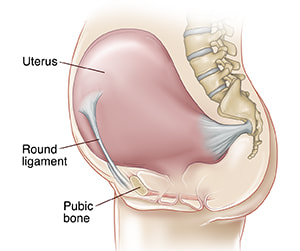|
Pregnancy is a time of great and fast change. The body naturally becomes more flexible, the abdominal muscles stretch and can weaken, our center of gravity shifts forward adding stress to the lower back and pelvis, etc. All of these changes can create discomfort, and besides lower back pain, round ligament pain is the most common complaint we hear from expecting moms. Why is that? Let’s do a quick anatomy review: The uterus is anchored in the pelvis with an assortment of ligaments and soft tissue, all designed to stretch and support the baby as it grows. Majority of our ligaments are meant to hold two bones together, such as those in the ankle or wrist. Their job is to be stable and limit too much stretch or movement. But the round ligament is special. Outside of pregnancy, it’s only about 4 inches long, connecting each side of the uterus to the front of the pelvis and into the groin. Its function is supporting the uterus as it goes through the changes of pregnancy, therefore it has the unique capability of being both stable and flexible. As the weeks progress the round ligament expands both wider and longer, reaching about double its original size by the time baby is full-term.
Ideally, all of these changes will occur comfortably and unimpeded. However, sometimes tension can develop, usually starting around the second trimester and worsening as the baby grows. The most common symptom of round ligament dysfunction is a sharp, stabbing spasm (or cramp) in the bottom of the belly with quick movement, i.e. rolling in bed, standing from sitting, turning too quickly, sneezing, etc. Less commonly, symptoms can be described a “pulling” sensation, general soreness under the belly, and even groin pain. Thankfully symptoms are generally harmless for both mom and baby, but they are certainly uncomfortable. What can you do about it? In the office: Pregnancy biomechanically changes the way a woman moves, and any shift in the pelvis or sacrum (sometimes referred to as the tailbone) can impact the ligaments and the uterus. Using the Webster adjusting technique, we focus on balancing these structures. Improving pelvic mobility and removing the strain of the round ligaments allows the uterus to comfortably suspend within the bowl of the pelvis. We also release tension in the muscles allowing for smoother and more comfortable motion. At home:
I hope these tips are useful, having the right tools and support you need during pregnancy are the keys to a comfortable one! Dr. Bachelor
0 Comments
Your comment will be posted after it is approved.
Leave a Reply. |
AuthorsDr. MJ Wegmann, Archives
July 2023
Categories
All
|


 RSS Feed
RSS Feed